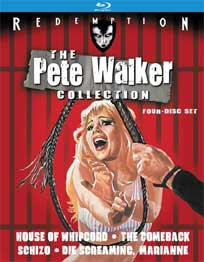 THE
PETE WALKER COLLECTION (1971-1978)
THE
PETE WALKER COLLECTION (1971-1978)Director: Pete Walker
Kino Lorber/Redemption Films
 THE
PETE WALKER COLLECTION (1971-1978)
THE
PETE WALKER COLLECTION (1971-1978)
In DIE SCREAMING, MARIANNE (1971), Marianne “The Hips” MacDonald (Susan George, STRAW DOGS) lives life on the run, from go-go dancing in Portugal to shacking up and intending to marry Sebastian (Christopher Sandford, DEEP END) after he picks her up hitchhiking and spirits her away to the relative safety of London. In spite of a two-week courtship, Marianne is suddenly having misgivings about marrying Sebastian and negotiates a clerical error that finds Sebastian’s best man Eli (Barry Evans, ADVENTURES OF A TAXI DRIVER) listed as her groom on the marriage certificate; it’s a good thing too as Sebastian has been in contact with Marianne’s father “The Judge” (Leo Genn, A LIZARD IN A WOMAN’S SKIN) who is living in Algarve with his other daughter Hildegarde (Judy Huxtable, SCREAM AND SCREAM AGAIN) who are eager to get Marianne to reveal the number of a Swiss bank account left to her by her mother that includes a ton of money as well as incriminating documents on her father’s career. While Eli offers a friendly shoulder and the use of his flat, Sebastian heads back to Portugal. The Judge wants the documents and Hildegarde wants the money (and her father). When they learn (under duress) that Marianne is married, The Judge offers Sebastian a payment to bring Marianne to Portugal before her birthday, and Hildegarde makes her own deal with Sebastian…
 Perhaps
it’s the sunstruck Portuguese setting, but DIE SCREAMING, MARIANNE almost
at times feels like a Jess Franco film without the nudity and palpable atmosphere
of sleaze (despite the incestuous angle between Hildegarde and her father).
Despite the potential for prurience, there is precious little for exploitation
fans to enjoy. Other than a handful of entertaining bits in the first half –
including some choice lines from Genn like “We do not mention money at
my dinner table,” followed by, “Now tell me, did you fornicate with
Marianne?” and a sequence in which Eli is nearly “rubbed out”
by two men posing as police officers that is somewhat suspenseful as well as
humorous – it’s a bit of a slog until about fifty minutes in when
Marianne and Eli accompany Sebastian back to Portugal to “go see The Judge”
knowing full well that Sebastian is not to be trusted. Things get interesting
once all of the main characters are finally brought together, with some skulking
around The Judge’s villa and some attempted murders before things are
wrapped up in a somewhat rushed fashion. Kenneth Hendel – who plays The
Judge’s sinister servant/enforcer Rodriguez – also appeared in Walker’s
MAN OF VIOLENCE and THE FOUR DIMENSIONS OF GRETA. Anthony Sharp (who would play
the deranged priest in Walker’s THE HOUSE OF MORTAL SIN) appears in a
brief role as a justice of the peace. Composer/music director Johnny Green’s
daughter Kathe sings the mournful theme song (“Love and I will never meet,
love’s not for you Marianne”). Cinematographer Norman Langley had
shot Walker’s MAN OF VIOLENCE and would work again with him as DP on Walker’s
last film THE HOUSE OF THE LONG SHADOWS.
Perhaps
it’s the sunstruck Portuguese setting, but DIE SCREAMING, MARIANNE almost
at times feels like a Jess Franco film without the nudity and palpable atmosphere
of sleaze (despite the incestuous angle between Hildegarde and her father).
Despite the potential for prurience, there is precious little for exploitation
fans to enjoy. Other than a handful of entertaining bits in the first half –
including some choice lines from Genn like “We do not mention money at
my dinner table,” followed by, “Now tell me, did you fornicate with
Marianne?” and a sequence in which Eli is nearly “rubbed out”
by two men posing as police officers that is somewhat suspenseful as well as
humorous – it’s a bit of a slog until about fifty minutes in when
Marianne and Eli accompany Sebastian back to Portugal to “go see The Judge”
knowing full well that Sebastian is not to be trusted. Things get interesting
once all of the main characters are finally brought together, with some skulking
around The Judge’s villa and some attempted murders before things are
wrapped up in a somewhat rushed fashion. Kenneth Hendel – who plays The
Judge’s sinister servant/enforcer Rodriguez – also appeared in Walker’s
MAN OF VIOLENCE and THE FOUR DIMENSIONS OF GRETA. Anthony Sharp (who would play
the deranged priest in Walker’s THE HOUSE OF MORTAL SIN) appears in a
brief role as a justice of the peace. Composer/music director Johnny Green’s
daughter Kathe sings the mournful theme song (“Love and I will never meet,
love’s not for you Marianne”). Cinematographer Norman Langley had
shot Walker’s MAN OF VIOLENCE and would work again with him as DP on Walker’s
last film THE HOUSE OF THE LONG SHADOWS.

Released on VHS by Unicorn Home Video (in a version that reflected the US cut, which ran about fifteen minutes shorter) with a garishly gory cover that grossly misrepresented the exploitable content of the film (it was apparently supposed to be reissued on MPI’s Gorgon Video line but a review of the screener suggests that that version was missing the entire prologue), DIE SCREAMING MARIANNE – working title: REBOUND – made its initial digital bow stateside as part of Image Entertainment’s Euroshock Collection back in 2001 as an unmatted (but uncut) transfer. Media Blasters reissued the title in 2006 on the Shriek Show label in a new widescreen transfer (with a 5.1 upmix), porting over the commentary and other extras produced for Anchor Bay’s UK coffin box set (which sported a DTS upmix as well). Redemption’s HD transfer is framed at 1.66:1 and features an expectedly sharper image and more colorful representation of the awful seventies fashions (which stand out spectacularly against the sunburnt Portuguese locales). Grain is strong during the darker scenes, but I doubt it could look better short of some digital removal of some rare spots and scratches. The LPCM 2.0 mono track is as clean as it was on the previous release.
 English
Gothic author Jonathan Rigby moderates a commentary track with Walker,
who refers to George as the “quintessential dolly bird” and the
Madonna of the 1970s, and both participants seem captivated by her (for the
most part). Although composer Stanley Myers had not yet worked with Walker,
it was his flat that served as one of the London locations (the film’s
score was composed by Cyril Ornadel who had scored a couple of Walker’s
sexploitation pics). Walker also refers to his early days as an actor, and how
Hendel acting circles around him (in a play in which Walker was the lead) convinced
the director to give up acting. Walker mentions that Huxtable was to married
to actor Peter Cook who accompanied her on the Portuguese shoot (in a bit of
confusion here, Rigby says she eventually married costume designer Sean Kenny,
but Huxtable was married to Kenny – who died in 1973 – previously
and did indeed later marry Cook). Later in the track, Walker discusses the production’s
temporary hiatus over a supposed dispute with George (he told the papers the
production was scrapped but assured Genn, Cook, and his production manager that
it was a way to get back control over the production). Walker also mentions
that while the lead was written with George in mind, he would like to have had
someone like Ian McShane or Patrick Mower for the role essayed by Evans.
English
Gothic author Jonathan Rigby moderates a commentary track with Walker,
who refers to George as the “quintessential dolly bird” and the
Madonna of the 1970s, and both participants seem captivated by her (for the
most part). Although composer Stanley Myers had not yet worked with Walker,
it was his flat that served as one of the London locations (the film’s
score was composed by Cyril Ornadel who had scored a couple of Walker’s
sexploitation pics). Walker also refers to his early days as an actor, and how
Hendel acting circles around him (in a play in which Walker was the lead) convinced
the director to give up acting. Walker mentions that Huxtable was to married
to actor Peter Cook who accompanied her on the Portuguese shoot (in a bit of
confusion here, Rigby says she eventually married costume designer Sean Kenny,
but Huxtable was married to Kenny – who died in 1973 – previously
and did indeed later marry Cook). Later in the track, Walker discusses the production’s
temporary hiatus over a supposed dispute with George (he told the papers the
production was scrapped but assured Genn, Cook, and his production manager that
it was a way to get back control over the production). Walker also mentions
that while the lead was written with George in mind, he would like to have had
someone like Ian McShane or Patrick Mower for the role essayed by Evans.
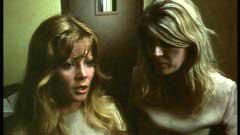
In HOUSE OF WHIPCORD, young French model Ann-Marie (Penny Irving, OLD DRACULA) – whose nude photoshoot in Kennsington Gardens got her arrested and fined – falls for the fatal charm of mysterious writer Mark E. Dessart (Robert Tayman, MOON ZERO TWO) who invites her to meet his parents at their remote country house. The house – to no one’s shock but Ann-Marie’s – turns out to be a house of correction for “depraved women” where a private court presided over by blind ex-judge Bailey (Patrick Barr, THE FLESH AND BLOOD SHOW) and prison governess Mrs. Wakehurst (Barbara Markham, SUNDAY BLOODY SUNDAY) dispense stricter sentences than the more permissive court system in the outside world, which are then enforced by sadistic guards Bates (Dorothy Gordon, SONS AND LOVERS) and Walker (Walker favorite Sheila Keith). Her cellmate Claire (Judy Robinson, THE INTERNECINE PROJECT) advises her of the prison’s three-strikes policy: 1) solitary, 2) flogging, and 3) execution by hanging. When Karen (Karen David) gets her third strike by hoarding food (she prefers bread to bangers and mash), Ann-Marie convinces Claire to help her rescue Karen; but the plan is botched, landing Ann-Marie in solitary, Claire a date with the lash, and a speedy hanging for Karen. Mrs. Wakehurst is disturbed by Ann-Marie’s defiance, since she reminds her of the French girl whose suicide lead to her leaving her post in disgrace thirty years before; so she decides to entrap Ann-Marie in order to hasten her execution. Meanwhile, back in London, Ann-Marie’s roommate Julia (Ann Michelle, HAUNTED) is trying to track her down after nine days without contact, but will she get to her in time?
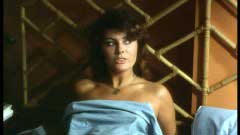 HOUSE
OF WHIPCORD was the first of Walker’s four collaborations with David McGillivray
(who has a small role in the film as a photographer), a writer for FILMS &
FILMING who expressed an interest in screenwriting. After Walker’s partnership
with Alfred Shaughnessy – who scripted Walker’s THE FLESH AND BLOOD
SHOW and TIFFANY JONES – ended (he went onto more “respectable”
work with TV projects like UPSTAIRS, DOWNSTAIRS), he contacted McGillivray with
his idea for the film. As far as “women in prison” films go, it’s
a unerotic experience far from the “flogging fantasy” the poster
art suggests, but it’s reasonably tense despite the script which makes
Ann-Marie so dim it’s hard to root for her (Irving’s French accent
belongs back on BENNY HILL where the actress appeared at least once as one of
the show’s many leer-worthy “smashing birds”) and a rather
lopsided PSYCHO-esque twist structure which needs to pad out Julia’s investigation
with endless scenes of her fighting with her boyfriend Terry (Walker school
chum Ray Brooks, THE LAST GRENADE) about leaving his wife. Barr is underused
as the blind judge who realizes all too late that he’s enabled corrupt
and sadistic behavior in the name of justice. Markham, despite being the film’s
most vile character, is somehow at the same time more sympathetic than Ann-Marie
because the character has demons and the actress conveys them well (even beyond
what the script gives her). Keith’s performance – which almost but
never actually spills over into camp – keeps the atmosphere from ever
getting too grim (“I’m going to make you ashamed of your body Ann-Marie
Di Verney, I’m going to see to that personally!”), and both she
and Gordon manage to eke out some audience sympathy late in the film (Keith’s
Walker because of a hint of concern and compassion underlying her character’s
veiled lesbian interest in Ann-Marie, and Gordon’s Bates in her display
of where her loyalties lie near the end of the film). Tayman is underused, but
is as effective a presence here as he was in his limited screentime as Count
Mitterhouse in the opening and closing scenes of Hammer’s VAMPIRE CIRCUS.
Michelle’s character is just a means to a tidy ending. Celia Imrie (BRIDGET
JONES’S DIARY) is one of the other barely-glimpsed inmates and Walker
regular Ivor Salter plays a truck driver who unknowingly thwarts Ann-Marie’s
escape attempt.
HOUSE
OF WHIPCORD was the first of Walker’s four collaborations with David McGillivray
(who has a small role in the film as a photographer), a writer for FILMS &
FILMING who expressed an interest in screenwriting. After Walker’s partnership
with Alfred Shaughnessy – who scripted Walker’s THE FLESH AND BLOOD
SHOW and TIFFANY JONES – ended (he went onto more “respectable”
work with TV projects like UPSTAIRS, DOWNSTAIRS), he contacted McGillivray with
his idea for the film. As far as “women in prison” films go, it’s
a unerotic experience far from the “flogging fantasy” the poster
art suggests, but it’s reasonably tense despite the script which makes
Ann-Marie so dim it’s hard to root for her (Irving’s French accent
belongs back on BENNY HILL where the actress appeared at least once as one of
the show’s many leer-worthy “smashing birds”) and a rather
lopsided PSYCHO-esque twist structure which needs to pad out Julia’s investigation
with endless scenes of her fighting with her boyfriend Terry (Walker school
chum Ray Brooks, THE LAST GRENADE) about leaving his wife. Barr is underused
as the blind judge who realizes all too late that he’s enabled corrupt
and sadistic behavior in the name of justice. Markham, despite being the film’s
most vile character, is somehow at the same time more sympathetic than Ann-Marie
because the character has demons and the actress conveys them well (even beyond
what the script gives her). Keith’s performance – which almost but
never actually spills over into camp – keeps the atmosphere from ever
getting too grim (“I’m going to make you ashamed of your body Ann-Marie
Di Verney, I’m going to see to that personally!”), and both she
and Gordon manage to eke out some audience sympathy late in the film (Keith’s
Walker because of a hint of concern and compassion underlying her character’s
veiled lesbian interest in Ann-Marie, and Gordon’s Bates in her display
of where her loyalties lie near the end of the film). Tayman is underused, but
is as effective a presence here as he was in his limited screentime as Count
Mitterhouse in the opening and closing scenes of Hammer’s VAMPIRE CIRCUS.
Michelle’s character is just a means to a tidy ending. Celia Imrie (BRIDGET
JONES’S DIARY) is one of the other barely-glimpsed inmates and Walker
regular Ivor Salter plays a truck driver who unknowingly thwarts Ann-Marie’s
escape attempt.

Released in the US by American International in 1974 under its original title – and then reissued by United Producers Releasing Organization in 1975 as PHOTOGRAPHER’S MODELS (in a double bill with former AIP pick-up THRILLER: A CRUEL PICTURE as HOOKER’S REVENGE) and STAG MODEL SLAUGHTER – HOUSE OF WHIPCORD made its VHS bow on Monterey Home Video. Its first DVD release was as another of Image’s Euroshock titles in an unmated transfer of British origin. In the UK, it also appeared in the Anchor Bay Walker set with an anamorphic overhaul, commentary, and audio upmixes; and it was this transfer that Shriek Show ported over for the film’s second US DVD release (retaining the commentary but dropping the DTS track). That transfer was somewhat over-matted at 1.73:1, although the US theatrical release would have been matted further to 1.85:1. Redemption’s release – which opens with the original British X-certificate card – is more comfortably framed at 1.66:1 and actually reveals an instance of frontal nudity during Irving’s shower scene that was cropped out of the previous transfer (although it may have been visible in Image’s open-matte disc and the older tape releases. Besides the more open framing, Redemption’s transfer is dramatically brighter and sharper (barring the scenes that utilize star filters and some low light scenes where the focusing is a little off). Peter Jessup’s cinematography is well-served here for the first time, with his sometimes delicate lighting more evident without the fading or contrast issues of the earlier transfers.
 The
commentary with Walker, Jessop (moderated by biographer Professor Steven Chibnall
who penned the Walker book Making Mischief) has been carried over again
and makes for an entertaining listen. Walker discusses how the slump in British
filmmaking in the seventies once the Americans pulled out their interests as
leaving a lot of talented people wanting to make features (in addition to or
rather than television and commercials), allowing Walker and others of the period
some choice cast and crew. Walker affirms his own conservative stance and Chibnall
points out a resemblance between Markham and Margaret Thatcher in her later
years – although Walker points out that Thatcher was more glamorous during
that period – but that Mary Whitehouse would probably have been a more
likely model (Whitehouse, a social activist against permissiveness in the media,
had a hand in stirring up the Video Nasty controversy even though she admitted
she had never seen one). In "Perversions of Justice" interview with
Pete Walker, by Elijah Drenner (13:58), Walker once again states that he is
more conservative than he has been perceived, and I interpret his comments as
meaning that he can be for capital and corporal punishment and less leniency
while still criticizing those who hide behind moral stances in order to indulge
their own sadistic desires (although he does offer it up for exploitation-hungry
audiences). The film’s theatrical trailer (2:37) is also included, along
with the same trailers for DIE SCREAMING, MARIANNE and THE COMEBACK
The
commentary with Walker, Jessop (moderated by biographer Professor Steven Chibnall
who penned the Walker book Making Mischief) has been carried over again
and makes for an entertaining listen. Walker discusses how the slump in British
filmmaking in the seventies once the Americans pulled out their interests as
leaving a lot of talented people wanting to make features (in addition to or
rather than television and commercials), allowing Walker and others of the period
some choice cast and crew. Walker affirms his own conservative stance and Chibnall
points out a resemblance between Markham and Margaret Thatcher in her later
years – although Walker points out that Thatcher was more glamorous during
that period – but that Mary Whitehouse would probably have been a more
likely model (Whitehouse, a social activist against permissiveness in the media,
had a hand in stirring up the Video Nasty controversy even though she admitted
she had never seen one). In "Perversions of Justice" interview with
Pete Walker, by Elijah Drenner (13:58), Walker once again states that he is
more conservative than he has been perceived, and I interpret his comments as
meaning that he can be for capital and corporal punishment and less leniency
while still criticizing those who hide behind moral stances in order to indulge
their own sadistic desires (although he does offer it up for exploitation-hungry
audiences). The film’s theatrical trailer (2:37) is also included, along
with the same trailers for DIE SCREAMING, MARIANNE and THE COMEBACK

In SCHIZO, no one believes newly married ice skater Samantha (Lynne Frederick, FOUR OF THE APOCALYPSE) when she fears that she is being stalked and terrorized by William Haskin (Jack Watson, TOWER OF EVIL) who was institutionalized for the murder of Samantha’s mother twenty years previous. Her husband Alan (singer John Leyton) and her prank-playing best friend Beth (Stephanie Beacham, AND NOW THE SCREAMING STARTS) think she’s stressed, Beth’s psychologist boyfriend Leonard (John Fraser, no more fortunate than as Catherine Deneuve’s suitor in REPULSION) is more interested in probing her repressed traumatic memories than indulging her delusions of persecution, but people are beginning to die around her. Alan’s housekeeper Mrs. Wallace (Queenie Watts, UP THE JUNCTION) suggests that Samantha consult the spirits via her daughter Joy (Trisha Mortimer, FRIGHTMARE) and the resulting séance just affirms that the killer is getting closer and closer to Samantha.
 SCHIZO
made its VHS debut stateside through United Home Video (now VCI) – in
a simple, attractive clamshell case with artwork suggesting a more recent slasher
film – and then later through Media Home Entertainment. It’s first
US DVD release was in 2001 through Image (once again as part of their Euroshock
line). That barebones release was an improvement over DIE SCREAMING MARIANNE
in that it featured a new progressive, anamorphic widescreen (1.74:1) transfer
derived from a British print source going by the Warner Bros. logo (SCHIZO was
distributed in all territories by Warner except America, where it was released
by Niles International as it opens on the VCI tape). It was not part of the
UK Anchor Bay set, so it was not ported over by Shriek Show for a reissue. In
2008, Redemption Films USA reissued the film utilizing the same anamorphic master,
but the release was a step down in other respects with typically ugly red and
black Redemption cover art of the period and a terrible menu. SCHIZO has always
looked good in the digital format, and Kino/Redemption’s 1080p 1.78:1-framed
transfer is the best of the bunch. Parts of the prologue look a bit hazy, but
that’s the heightened resolution making the North-east England location’s
foggy morning more apparent than it was on the SD transfers where shots just
looked somewhat defocused. The rest of the picture is as fine as Jessop’s
location lighting allows (with grain more noticeable in the darker scenes).
SCHIZO
made its VHS debut stateside through United Home Video (now VCI) – in
a simple, attractive clamshell case with artwork suggesting a more recent slasher
film – and then later through Media Home Entertainment. It’s first
US DVD release was in 2001 through Image (once again as part of their Euroshock
line). That barebones release was an improvement over DIE SCREAMING MARIANNE
in that it featured a new progressive, anamorphic widescreen (1.74:1) transfer
derived from a British print source going by the Warner Bros. logo (SCHIZO was
distributed in all territories by Warner except America, where it was released
by Niles International as it opens on the VCI tape). It was not part of the
UK Anchor Bay set, so it was not ported over by Shriek Show for a reissue. In
2008, Redemption Films USA reissued the film utilizing the same anamorphic master,
but the release was a step down in other respects with typically ugly red and
black Redemption cover art of the period and a terrible menu. SCHIZO has always
looked good in the digital format, and Kino/Redemption’s 1080p 1.78:1-framed
transfer is the best of the bunch. Parts of the prologue look a bit hazy, but
that’s the heightened resolution making the North-east England location’s
foggy morning more apparent than it was on the SD transfers where shots just
looked somewhat defocused. The rest of the picture is as fine as Jessop’s
location lighting allows (with grain more noticeable in the darker scenes).

Out of the four Pete Walker/David McGillivray collaborations, SCHIZO is the one that feels most like a body count picture because the plot very flimsily supports a handful of murders about as well as THE FLESH AND BLOOD SHOW earlier and THE COMEBACK afterwards (although with murders that are more brutal than both), but it’s otherwise one big gimmick (starting with the opening narration defining schizophrenia, although I prefer the US poster’s definition: “When the left hand doesn’t know who the right hand is killing”). Watson does his best, but Frederick isn’t a very interesting woman-in-peril. Co-star Beacham – who had already appeared in Walker’s HOUSE OF MORTAL SIN – would have been a more interesting lead (if a bit of a top-heavy ice skater). The longer the film tries to push the stalking angle, the more apparent the final revelation becomes.
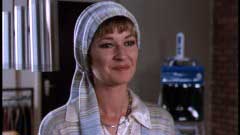 Sadly,
there’s no commentary this time around (a pairing of Walker and McGillivray
would have been entertaining since the latter – while not too informative
– livened up the Norman J. Warren commentary tracks on the Anchor Bay
UK set discs of SATAN’S SLAVE and TERROR), but Warren appears in another
new interview “My Sweet SCHIZO” (12:36) and explains that he wanted
to outdo Hitchcock in this film by perpetrating the “ultimate lie”
on the audience (writer McGillivray apparently loathed the idea). Walker admits
that the terrific title was a bit of a spoiler (the SCHIZOID retitling didn’t
really help Lucio Fulci’s A LIZARD IN A WOMAN’S SKIN either), but
he doesn’t mention the narrated prologue defining schizophrenia. He says
he is more comfortable being known for his horror work than his sexploitation
films (and ruminates on the fine line between giggles and gasps with regards
to shooting violent death scenes). The disc also includes the same three Walker
trailers (apparently they could not find usable sources for any trailers for
SCHIZO).
Sadly,
there’s no commentary this time around (a pairing of Walker and McGillivray
would have been entertaining since the latter – while not too informative
– livened up the Norman J. Warren commentary tracks on the Anchor Bay
UK set discs of SATAN’S SLAVE and TERROR), but Warren appears in another
new interview “My Sweet SCHIZO” (12:36) and explains that he wanted
to outdo Hitchcock in this film by perpetrating the “ultimate lie”
on the audience (writer McGillivray apparently loathed the idea). Walker admits
that the terrific title was a bit of a spoiler (the SCHIZOID retitling didn’t
really help Lucio Fulci’s A LIZARD IN A WOMAN’S SKIN either), but
he doesn’t mention the narrated prologue defining schizophrenia. He says
he is more comfortable being known for his horror work than his sexploitation
films (and ruminates on the fine line between giggles and gasps with regards
to shooting violent death scenes). The disc also includes the same three Walker
trailers (apparently they could not find usable sources for any trailers for
SCHIZO).
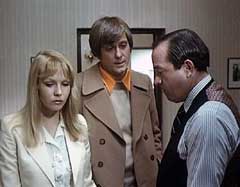
In THE COMEBACK, Nick Cooper (singer Jack Jones) has recently divorced his wife Gail (Jack Palance’s daughter Holly, THE OMEN’s suicidal nanny) – who convinced him to give up singing – and is planning to make a comeback, recording a new album in England. His agent Webster Jones (David Doyle, TV’s CHARLIE’S ANGELS) arranges for him to stay in a country house staffed by housekeeper Mr. and Mrs. B (LAST OF THE SUMMER WINE’s Bill Owen and Walker favorite Sheila Keith); which is just as well since Nick’s riverside loft is a mess as an old hag with a sickle hacked Gail to pieces on the staircase and left her corpse to decompose. Nick finds further distraction in Webster’s secretary Linda (Pamela Stephenson, BLOODBATH AT THE HOUSE OF DEATH) but cries and laughter in the night, moldering corpses in the basement, and severed rotting heads in the hatbox set Nick on edge while everyone else thinks he’s cracking under pressure (well everyone else who hasn’t been slashed and hacked to bits by the cackling old hag). Could the kindly old housekeepers know more than they are letting on – oh, come one, one of them is Sheila Keith, of course they do…
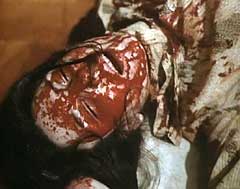 THE
COMEBACK was written by returning writer Murray Smith, and it’s a bit
more “old dark house” than the McGillivray. While the finished product
is an amusing diversion, and Walker says in the interview that the combination
of older leads and the showbiz setting made it a more mature mainstream thriller
rather than a horror film, it doesn't exactly compare favorably even with SCHIZO
among the Walker/McGillivray films. Walker himself admits he may have misjudged
his audience by putting macho Jones in a role commonly characterized as a terrorized
vulnerable, and sometimes scantily clad, “final girl” (although
Jones does show a bit more skin than love interest Stephenson); and he might
have gotten away with it had he and Smith been able to engineer the kind of
disturbing, blunt, violent set-pieces that characterized the best of the McGillivray
collaborations in order to convincingly drive Jones into hysterics. Some other
suspects are thrown in (David Doyle’s agent washes something red off of
his hands in one scene and crossdresses in another scene, and young Harry (Peter
Turner, THE KRAYS) expresses a certain “otherness” in his slightly
possessive behavior over Nick before he gets hacked up on a visit to Nick’s
loft (this film might have been more novel had it taken the SCHIZO approach).
HOUSE OF WHIPCORD’s Penny Irving returns in a small role and Richard Johnson
(THE HAUNTING) has a one scene role as Nick’s doctor. Peter Jessop’s
photography is a plus as usual, and Stanley Myers’ score (his last for
Walker) is typically better than the project deserves.
THE
COMEBACK was written by returning writer Murray Smith, and it’s a bit
more “old dark house” than the McGillivray. While the finished product
is an amusing diversion, and Walker says in the interview that the combination
of older leads and the showbiz setting made it a more mature mainstream thriller
rather than a horror film, it doesn't exactly compare favorably even with SCHIZO
among the Walker/McGillivray films. Walker himself admits he may have misjudged
his audience by putting macho Jones in a role commonly characterized as a terrorized
vulnerable, and sometimes scantily clad, “final girl” (although
Jones does show a bit more skin than love interest Stephenson); and he might
have gotten away with it had he and Smith been able to engineer the kind of
disturbing, blunt, violent set-pieces that characterized the best of the McGillivray
collaborations in order to convincingly drive Jones into hysterics. Some other
suspects are thrown in (David Doyle’s agent washes something red off of
his hands in one scene and crossdresses in another scene, and young Harry (Peter
Turner, THE KRAYS) expresses a certain “otherness” in his slightly
possessive behavior over Nick before he gets hacked up on a visit to Nick’s
loft (this film might have been more novel had it taken the SCHIZO approach).
HOUSE OF WHIPCORD’s Penny Irving returns in a small role and Richard Johnson
(THE HAUNTING) has a one scene role as Nick’s doctor. Peter Jessop’s
photography is a plus as usual, and Stanley Myers’ score (his last for
Walker) is typically better than the project deserves.

THE COMEBACK was not among Image’s Euroshock releases, and did not get a DVD release stateside until 2006 when Media Blasters/Shriek Show released it utilizing the same open-matte transfer featured on the Anchor Bay UK set (with Walker/Rigby commentary); thus, Redemption’s new 1080P widescreen (1.85:1) transfer is a first stateside (presumably it was the same master used for Odeon’s 2011 UK anamorphic DVD reissue). The older open-matte transfer didn’t look new, but it also didn’t look too bad either. Redemption’s 1.85:1 transfer looks great with a sharper colorful image for the most part (as with the other films, the more diffused lighting in scenes shot with filtration – here, the scenes in Nick‘s skylit loft – result in somewhat milkier shadows but the bulk of the presentation’s darker scenes are appropriately shadowy (and grainy). Jonathan Rigby joins Walker for another commentary track and points out that the plot seems very much like something Jimmy Sangster would have scripted for Hammer in the sixties (not to mention FEAR IN THE NIGHT in the seventies and a number of Sangster’s American TV projects during that decade). Walker says he originally had Bryan Ferry in mind for the lead (he had previously offered the singer a role in SCHIZO) and admits that the shot of Jones getting out of bed and in the shower were cheeky nods to the fact that he is playing the woman-in-peril role. Elijah Drenner interviews Walker for another interview in "Slasher Serenade" (13:23) and comments again about how he may have misjudged the film commercially, but that the changes on this project from his McGillivray collaborations were because he was tired of being taken to task by liberal critics for the morality of his films. He reveals that he contacted Jones’ London agent after seeing him in a guest role on McMILLAN AND WIFE, and the singer himself pops up uncredited (at least on the cover and extras menu description of the featurette. Jones talks about some of his TV guest roles, shooting the film during the day and performing at night while in London, the screening of the film for his fanclub who were shocked at his character’s use of the F-word, and the acting tips he got from Sheila Keith. Jones takes credit (and blame) for the title change from the original THE DAY THE SCREAMING STOPPED (which he admits probably would have sold the film better).
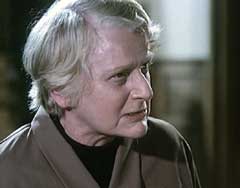 With
perhaps the exception of HOUSE OF WHIPCORD, Redemption’s PETE WALKER COLLECTION
is a bit of a disappointment when it comes to entertainment value (although
I actually enjoyed DIE SCREAMING, MARIANNE a fraction more than I ever have
in its previous home video incarnations); but Walker fans may be interested
to know that Redemption is planning a second set and that rights holder Euro
London’s Walker holdings also include FRIGHTMARE, THE HOUSE OF MORTAL
SIN and THE FLESH AND BLOOD SHOW as well as some of his sexploitation pics (FRIGHTMARE
is reportedly in the works now). International fans should note that Kino/Redemption’s
set is encoded for Region A playback only. The four films are not available
separately, but the inclusion of the same trailers on each disc and the 24-27
numbering on the cover spine suggest that they could come out individually at
a later time. (Eric
Cotenas)
With
perhaps the exception of HOUSE OF WHIPCORD, Redemption’s PETE WALKER COLLECTION
is a bit of a disappointment when it comes to entertainment value (although
I actually enjoyed DIE SCREAMING, MARIANNE a fraction more than I ever have
in its previous home video incarnations); but Walker fans may be interested
to know that Redemption is planning a second set and that rights holder Euro
London’s Walker holdings also include FRIGHTMARE, THE HOUSE OF MORTAL
SIN and THE FLESH AND BLOOD SHOW as well as some of his sexploitation pics (FRIGHTMARE
is reportedly in the works now). International fans should note that Kino/Redemption’s
set is encoded for Region A playback only. The four films are not available
separately, but the inclusion of the same trailers on each disc and the 24-27
numbering on the cover spine suggest that they could come out individually at
a later time. (Eric
Cotenas)